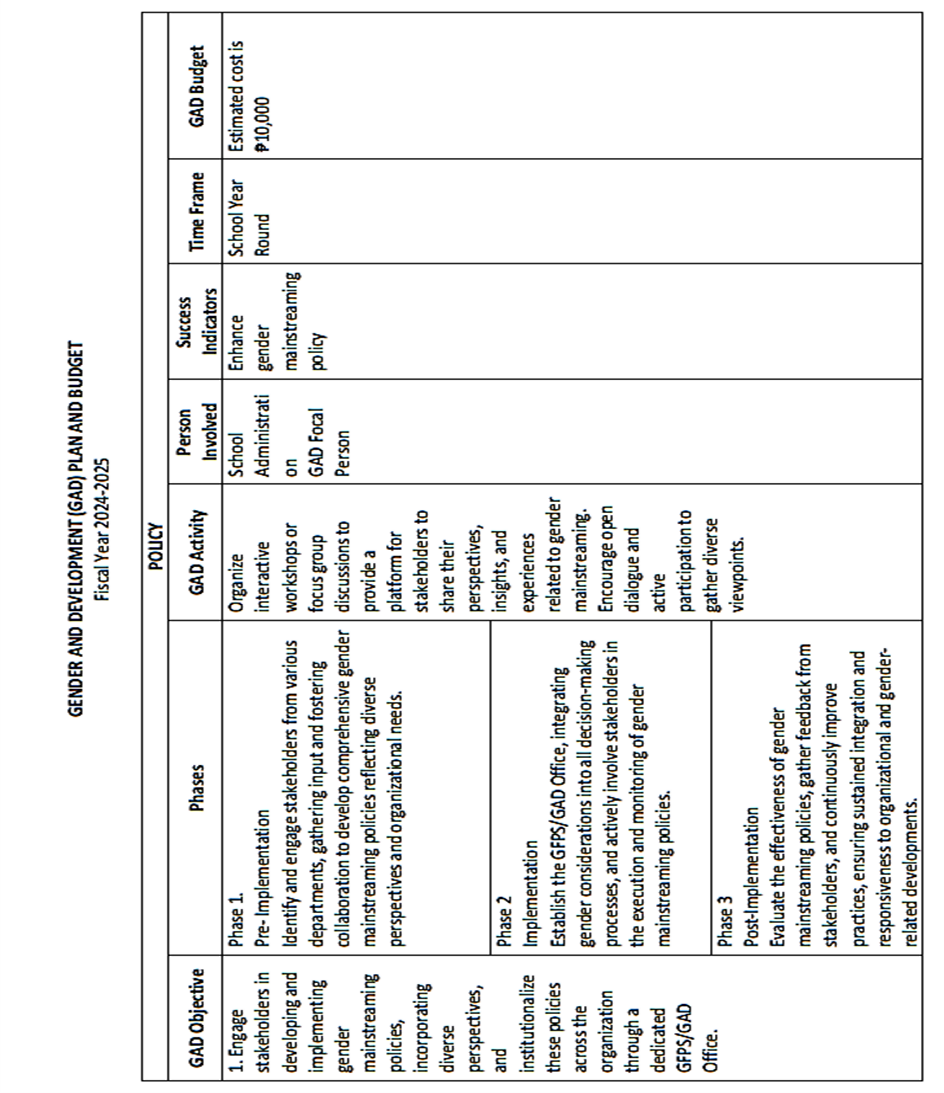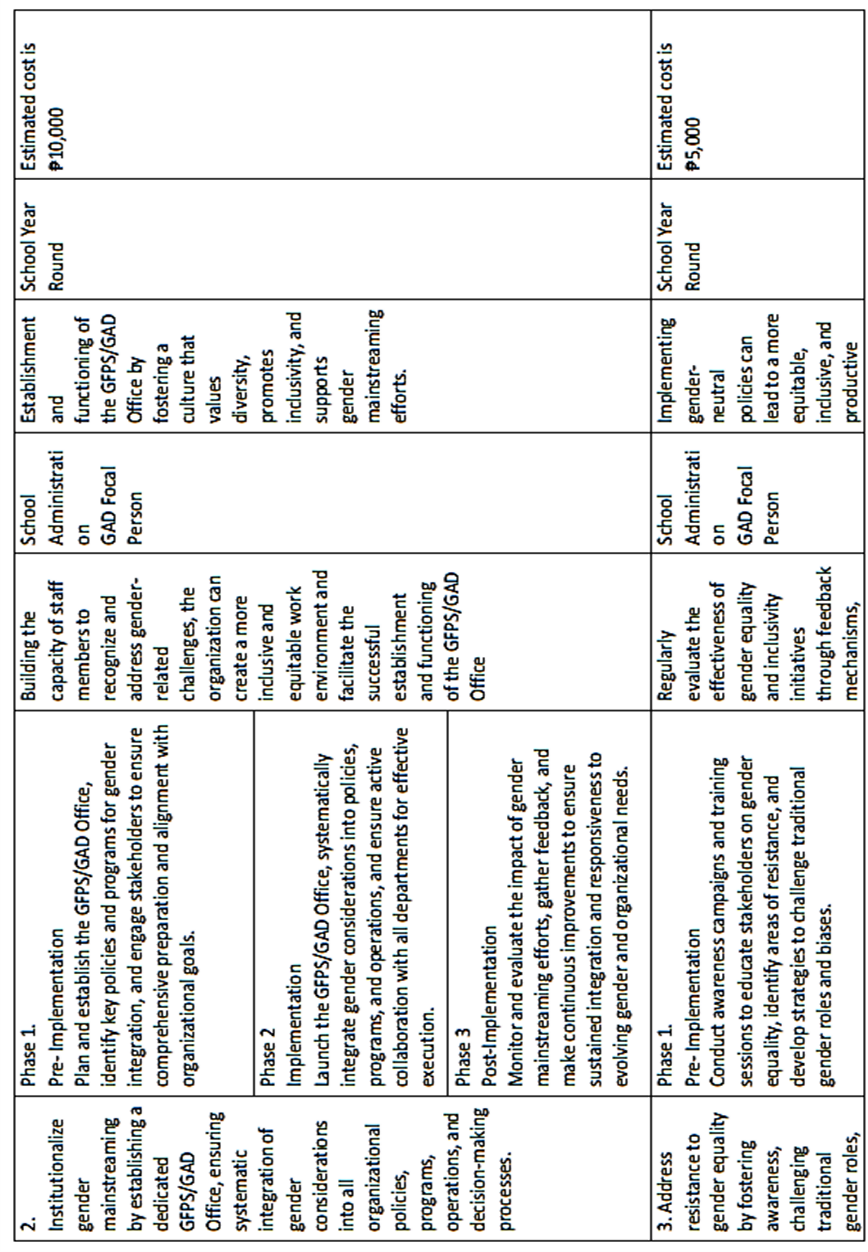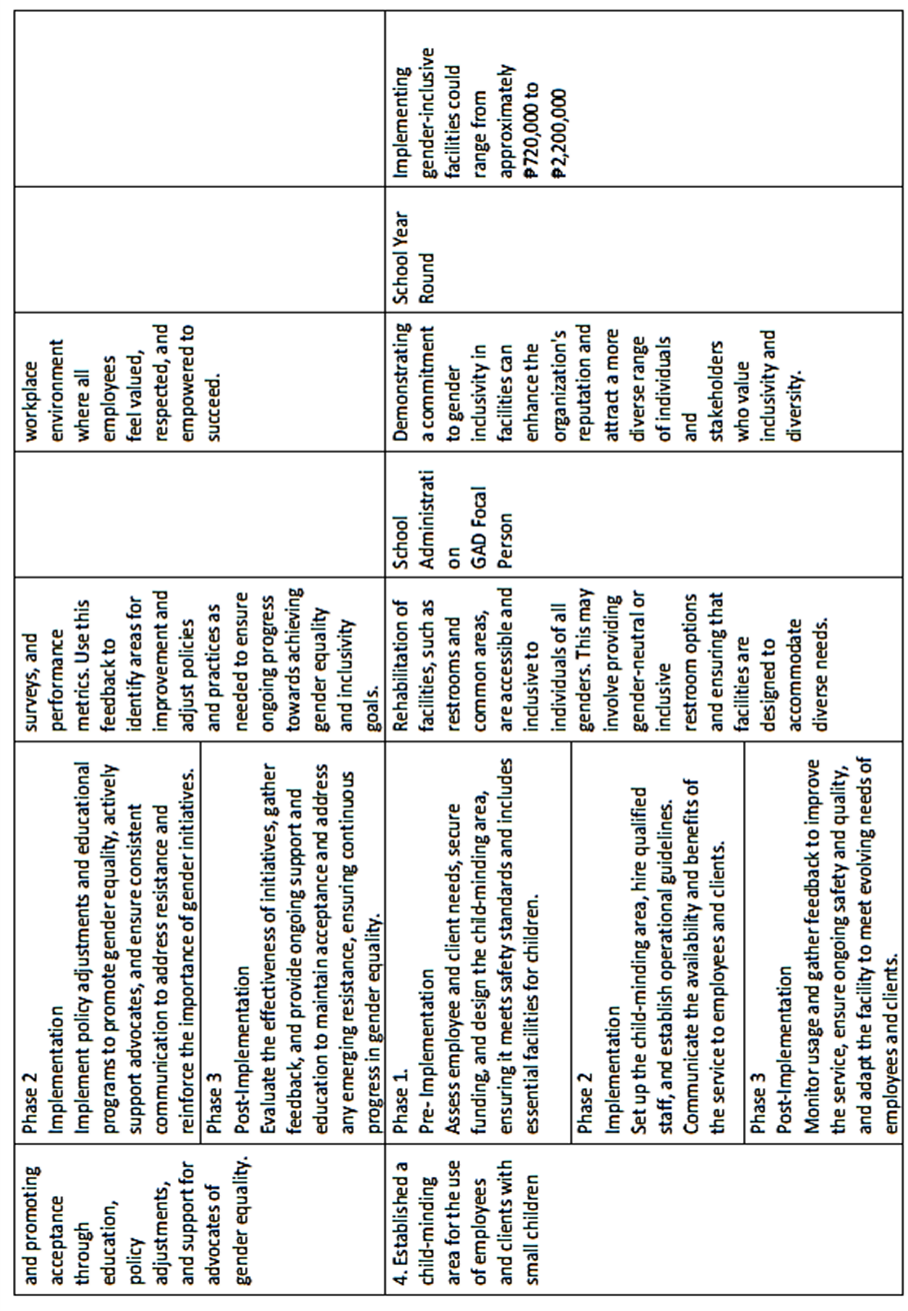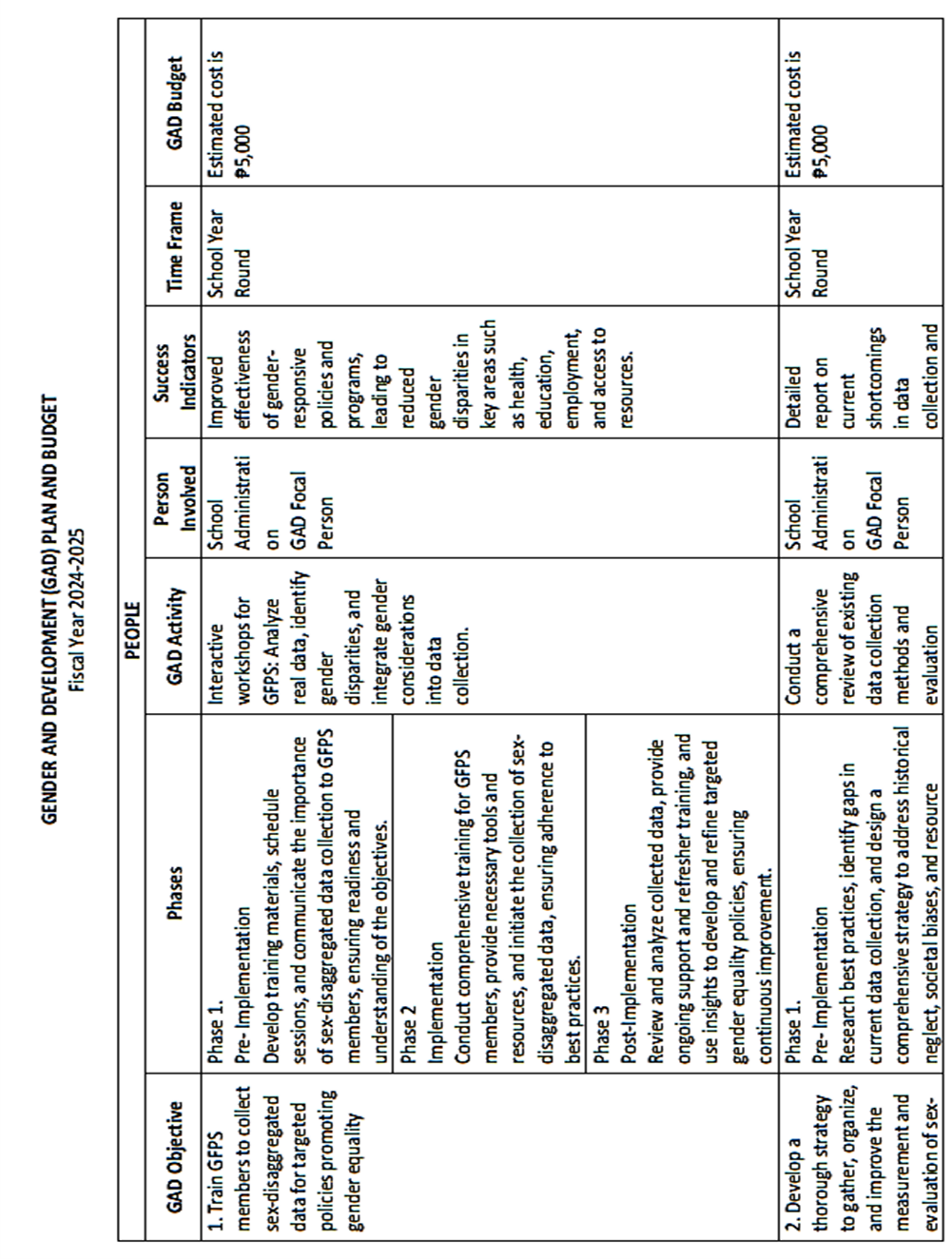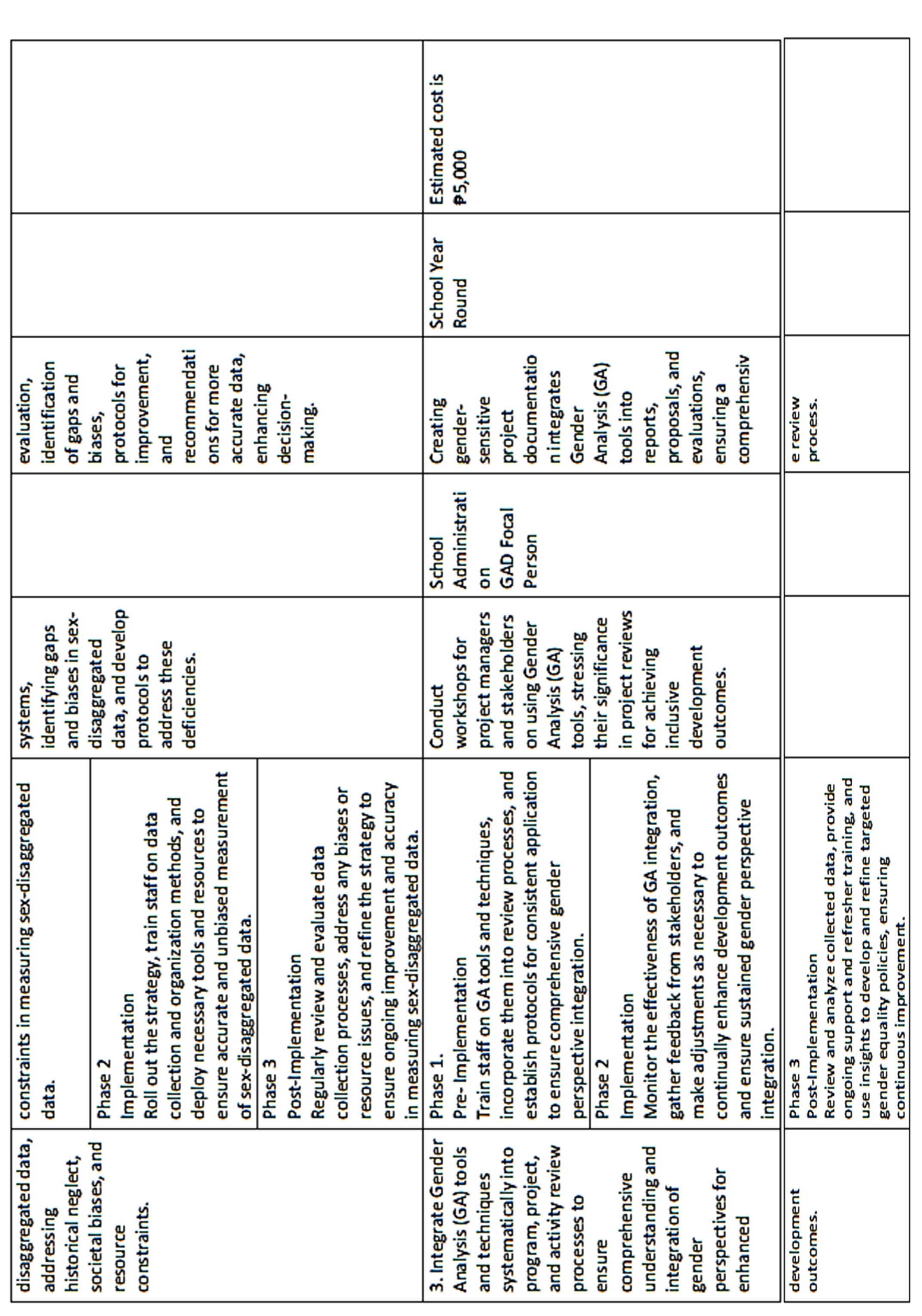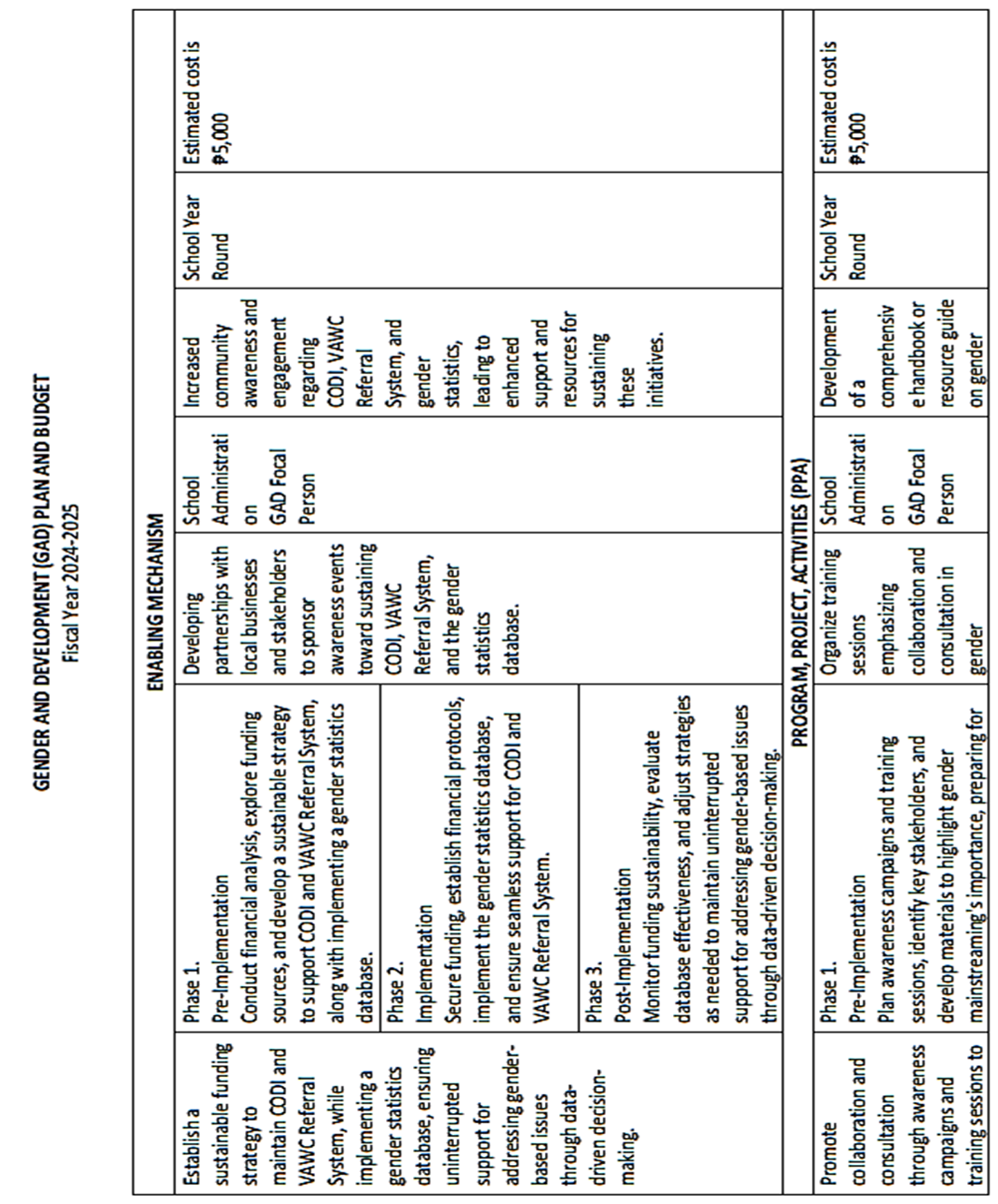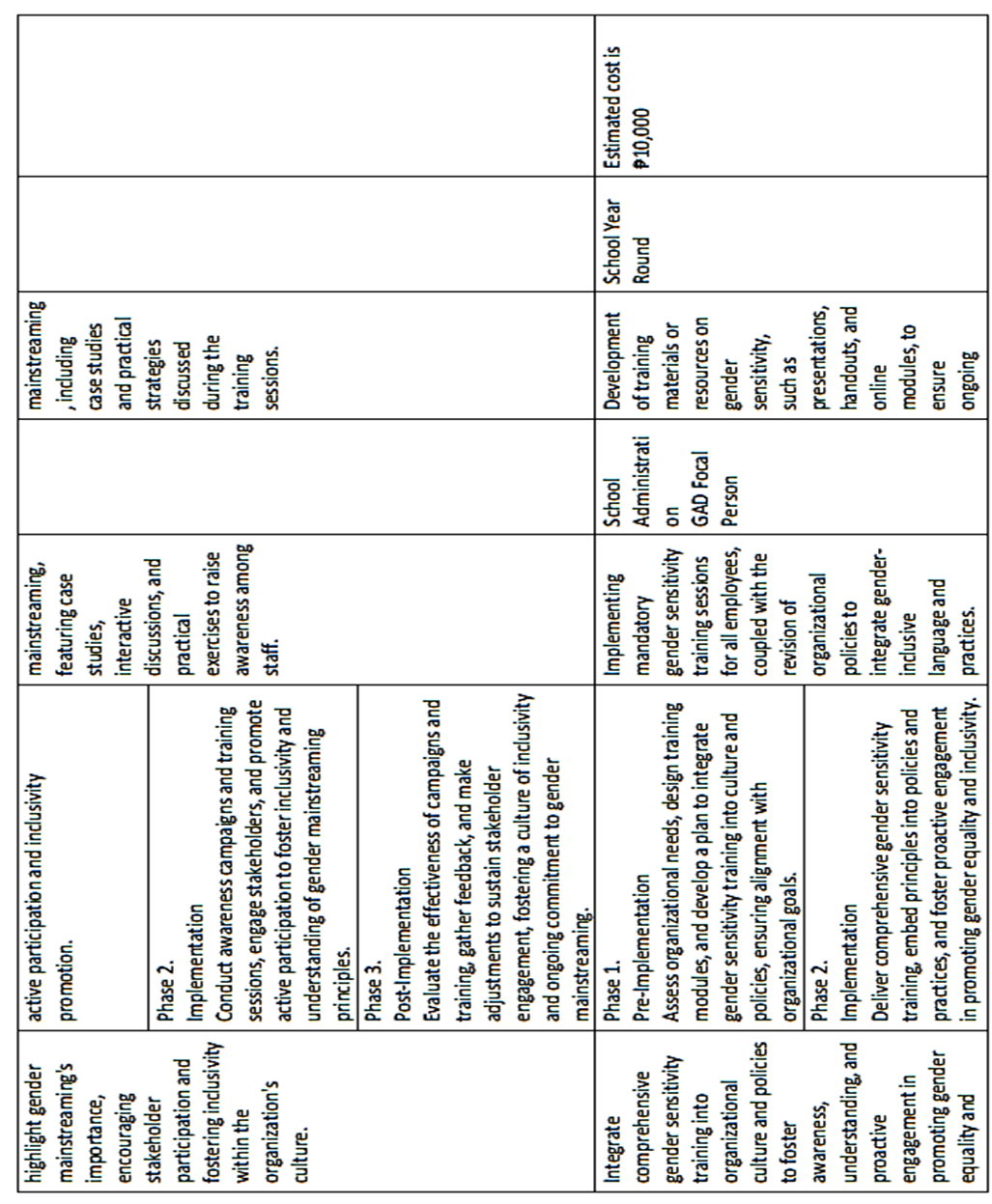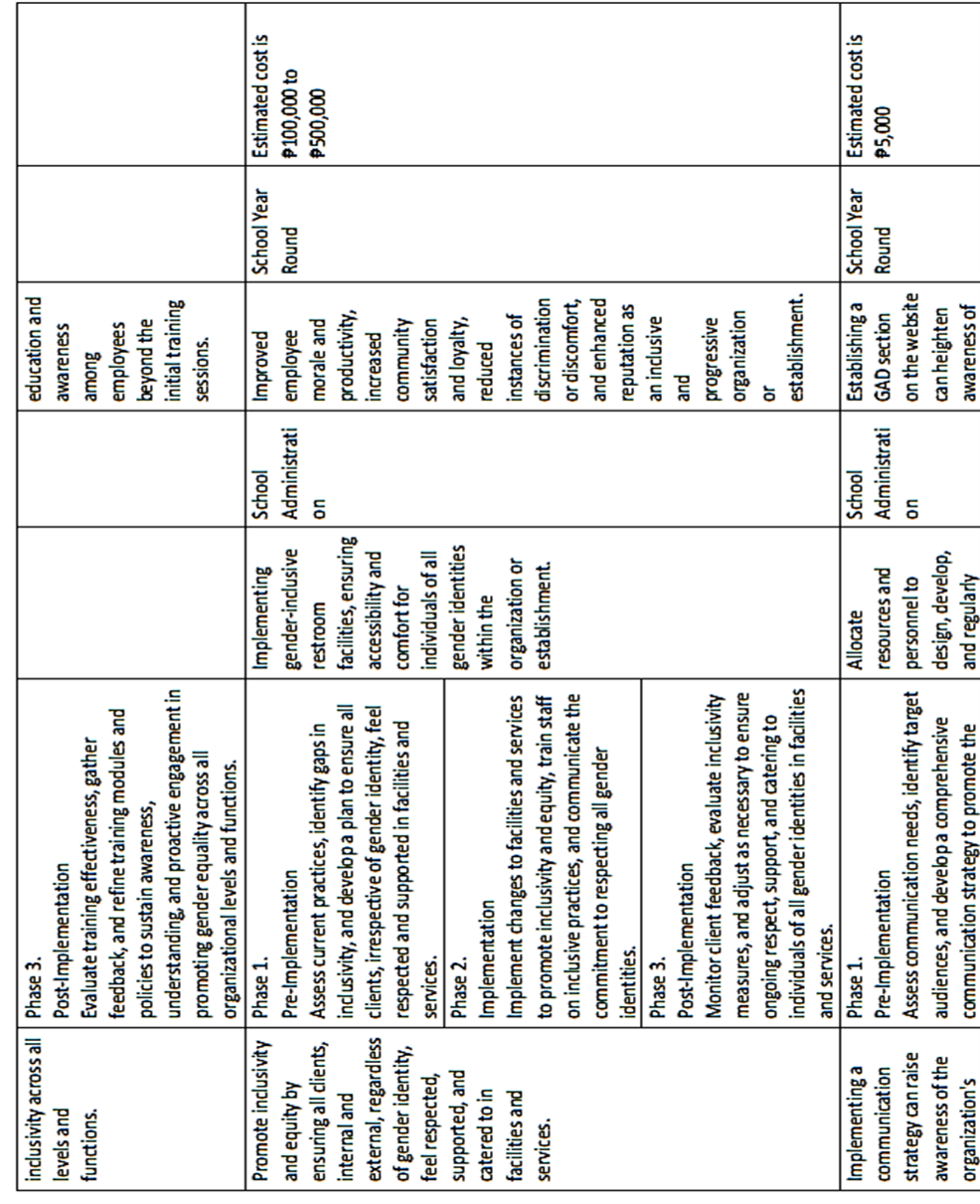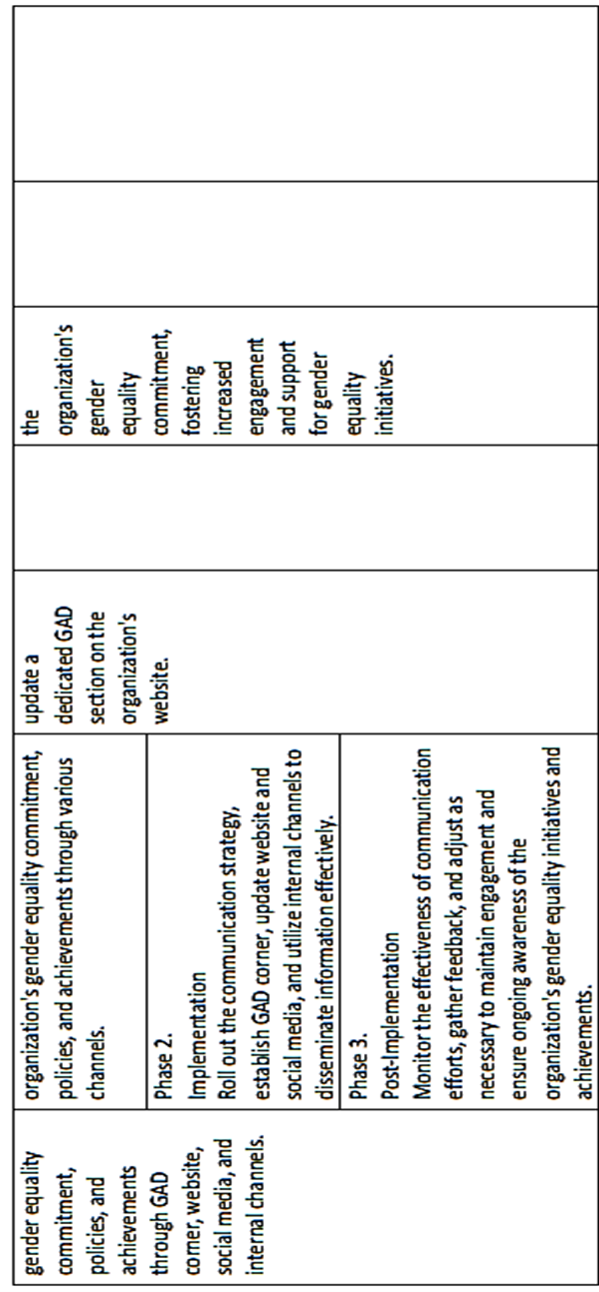Level of Awareness on Gender and Development at Caloocan High School: Basis for Enhanced Development Plan
- Cristina E. Doguiles, LPT
- Jose M. Rapsing, LPT, PhD.
- 2565-2579
- Aug 14, 2024
- Educational Management
Level of Awareness on Gender and Development at Caloocan High School: Basis for Enhanced Development Plan
Cristina E. Doguiles, LPT and Jose M. Rapsing, LPT, PhD.
City of Malabon University, Malabon, Metro Manila, Philippines
DOI: https://dx.doi.org/10.47772/IJRISS.2024.803186S
Received: 19 June 2024; Revised: 07 July 2024; Accepted: 13 July 2024; Published: 14 August 2024
ABSTRACT
The purpose of this study was to determine the level of awareness of Caloocan High School teaching personnel in the gender and development program (GAD). The study utilized the descriptive method since it elicited information or data from the respondents using a survey instrument. Two hundred eighty-three 283 teachers of Caloocan High School and their task was to assess the Gender and Development program. The data gathered were tallied, tabulated, and interpreted using the weighted mean and Kruskal Wallis Test.
The findings revealed that the level of awareness of Caloocan High School teachers in the Gender and Development (GAD) program in terms of policy, people, enabling mechanisms, and program, projects, and activities (PPA) are interpreted as “aware”
Based on the findings, an enhanced Gender and Development program was crafted to provide further opportunities for teachers to increase their level of awareness.
Since the researchers made use of teachers in Caloocan High School in a particular school, a set of respondents from other divisions to validate the findings may be taken into consideration for further studies.
Keywords: Gender, Gender and Development, Gender Focal Point System, people, policy, enabling mechanism, program, project, activities.
INTRODUCTION
Despite the implementation of DepEd Order No. 32, issued in 2017 and commonly referred to as the Gender-Responsive Basic Education Policy, with the objectives to promote gender equality and prevent discrimination in the DepEd workplace, there remain instances of gender-related issues.
However, during the implementation, the researcher observed that in relation to the list of common gender issues and GAD mandates based on DM-PHROD-2020-00335 (DepEd Office of the Undersecretary, 2020) and Caloocan High School GAD Accomplishment Report for the year 2021-2022, there are serious problems within Caloocan High School such as the GAD focal point system’s weak capacity, National Women’s month not being known, Safe Space Act in Basic Education is ignored. Gender equity in Disaster Risk Reduction Management (DRRM) within schools is undermined by poor regard for it and while absence of information on GAD-focused teachers and students. School facilities are gender biased as there is no gender-neutral toilet and proper facilities to address the reproductive needs of women and men employees such as lactation rooms and child-minding centers. Educational personnel lacking knowledge about non-sexist language usage. There is a lack of sex-disaggregated data that will be used in the planning, implementation, and monitoring of programs and projects (PPA). The mismanagement of GAD Clubs implies deep systemic neglect that demands both fundamental changes and an inclusive enlightened future.
In response, several studies asserted the effective implementation of DepEd Order No. 32. S. 2017, highlights the success of the GAD Program within the Department of Education, which seeks to eliminate gender biases, empower girls and women, and challenge societal norms perpetuating gender inequality by integrating gender perspectives into educational policies and practices. The establishment of a consultation mechanism involving teaching and non-teaching personnel, as well as students, to facilitate decision-making within schools. Additionally, regular meetings with relevant stakeholders regarding GAD programs, activities, and issues have led to increased awareness and engagement. (Sumadsad & Tuazon, 2016; Villagracia, 2023)
Only a limited number of research endeavors such as Bacquian et al. (2023), have explicitly delved into the extent of awareness about the effective implementation of Gender and Development, as evaluated by educators who are also participants. Nevertheless, akin to numerous other initiatives, educators faced difficulties in executing the Gender and Development program. Consequently, there is a need for a well-devised strategy to enhance the execution of various Gender and Development-related activities aimed at fostering gender equality.
The research on GAD awareness in Caloocan High School is important for many reasons. This entails the extent to which the school community understands GAD philosophy and gender equality hence giving insight into the efficiency of existing programs and initiatives. The inquiry could go a long way in pointing out the limitations in understanding and perceptions by students, teachers, and other personnel which necessitate interventions that would improve their knowledge as well as promote a gender-sensitive environment within an institution.
Specifically, it pursued to answer to the following questions:
- What is the profile of the respondents in terms of:
1.1. Age,
1.2. Gender,
1.3. Civil Status,
1.4. Educational attainment,
1.5. Position, and
1.6. Length of service?
- What is the level of awareness of teachers of Caloocan High School about the Gender and Development Program in terms of the following:
2.1. Policy,
2.2. People,
2.3. Enabling Mechanisms, and
2.4. Programs, Projects, and Activities (PPA)?
- Is there any significant difference in the evaluation of the level of awareness of the Gender and Development Program in Caloocan High School teachers when grouped according to their profile?
- Based on the result of the study, what enhanced gender and development program can be proposed to the Caloocan High School teachers?
This study is quantitative that measures the level of awareness of Caloocan High School Teachers in the implementation of the GAD Program based on their profiles in terms of the following four critical points: policy, people, enabling mechanisms, and programs, projects, and activities (PPA) with accordance to PCW GAD Focal Point System (2022)
Formal interviews were conducted by the researcher to further support the findings. Although some policies, like the Gender-Responsive Basic Education Policy, were recognized, challenges in implementation remained evident. The respondents lacked familiarity with crucial mechanisms like the GAD Focal Point System and demonstrated insufficient use of data. There was an urgent need for enhanced communication channels and gender-sensitive approaches within educational institutions.
RESEARCH METHODOLOGY
The descriptive – analysis was used to determine level of awareness of Caloocan High School teachers towards Gender and Development (GAD) using a researcher-made survey-questionnaire.
In the study of the level of awareness of Gender and Development of Caloocan High School teachers, the researcher used a researcher-made survey questionnaire. Likewise, the researcher read various articles, GAD narrative report for School Year 2021-2022 which was submitted by different high schools in Caloocan, memorandums related to GAD, the Gender Mainstreaming Evaluation Tool, and the Harmonized Gender and Development Guidelines, all of which were used to construct indicators per variable pertinent to this research. The questionnaire was subjected to validation by different GAD Focal Persons in different schools in the Pobcaran District of Caloocan City.
The questionnaire consisted of two parts: 1) profile of the Caloocan High School teacher respondents which consist of age, gender, civil status, educational attainment, position, and length of service. The questionnaire about profile was aligned with the Sex-Disaggregated Data (SDD) in which according to the PCW Handbook (2016), the data is used for gender analysis to enhance the effectiveness of GAD implementation. 2) the level of awareness of the Gender and Development program that consists of ten questions for the following key points namely policy, people, enabling mechanisms, and programs, projects, and activities (PPA) that were rated using a 5-point Likert Scale with 5=”very aware”, 4=”aware”, 3=”neither aware nor unaware”, 2=”unaware”, and 1=”very unaware”. Furthermore, we determined the sample size by non-probability sampling method, specifically availability sampling and purposive or judgmental sampling.
To determine the level of awareness of the gender and development program of Caloocan High School faculty, the researcher used random sampling to meet the number of respondents required in this research.
According to Noor and Golzar (2022), random sampling is an extensively used sampling method in scientific research. Random sampling is selected for populations that are highly homogenous where the members of the research are randomly selected to participate in the research. Random sampling is the simplest and most common method of selecting a sample, in which the sample is selected unit by unit, with an equal probability of selection for each unit at each draw.
Respondents were limited to two hundred eighty-three (283) junior high school faculty members of Caloocan High School were sourced from eight (8) departments namely Filipino, English, Mathematics, Science, Araling Panlipunan, Technology and Livelihood Economics (TLE), Edukasyon sa Pagpapakatao (ESP), and Music, Arts, PE, and Health (MAPEH).
Before conducting the survey, the questionnaire was subjected to validation by different GAD Focal Persons in different schools in the Pobcaran District of Caloocan City. The questionnaire also underwent testing among Senior High School Teachers at Caloocan High School who were not part of the respondents. The reliability of the questionnaire was evaluated by calculating Cronbach’s alpha coefficients of internal consistency for each section. The results indicated a high level of reliability is “excellent.”
After having secured the necessary permissions from the Schools Division of Caloocan and School Head and School Administration of Caloocan High School, the researcher personally administered the questionnaires to the respondents and personally retrieved them thru google form. Then, the data were tabulated and interpreted.
To further support the findings, the researcher conducted formal interviews with selected respondents to craft an Enhanced GAD Development Plan. After that the conclusions and recommendations followed.
RESULTS AND DISCUSSION
There are four main questions raised from the statement of the problem. First is the profile of the respondents; second is the level of awareness of the respondents on four critical points; third is the significant in the evaluation of the level of awareness of the Gender and Development Program in Caloocan High School teachers when grouped according to their profile; and lastly is the enhanced GAD plan.
The study generated the following findings: The profile of the respondents from Caloocan High School was grouped according to their age, gender, civil status, educational attainment, position, and length of service. Out of 283 teacher-respondents of Caloocan High School, 119 or 42.05% were in the age bracket of 35 years old and below. In terms of gender, 219 respondents, or 77.39% were female. One hundred eighty-one (181) or 33.2% of respondents belonged to the bracket of married. The majority of the respondents were Bachelor’s Degree holders with a total of 199 or 70.3%. Two hundred fifty-four respondents, 254 or 89.8% were under the category of Teacher I to III, and the majority of the teaching force of Caloocan High School or 96 or 33.9% of the respondents have been in the service for 5 to 10 years.
The following studies explained the result in profiles: Villanueva, Suminguit, and Valdehueza (2023) state that new teachers bring fresh energy to education, while married teachers tend to be more nurturing; Sebastian et al. (2022) highlight that public elementary schools are predominantly staffed by women; and Abun et al. (2021) found that higher educational attainment and longer service are linked to higher self-efficacy among teachers and employees.
The level of awareness of Caloocan High School teachers on the Gender and Development (GAD) program when grouped according to their profile in terms of people got the highest with 3.65 while in the PPA got the lowest mean of 3.45. While the enabling mechanism and policy got the mean of 3.51 and 3.61 respectively.
Duma (2022) asserts that collecting gender-specific data improves monitoring systems and aids in establishing Gender and Development Focal Point Systems (GFPS) per the Magna Carta of Women (MCW); Orge (2021) emphasizes the need for gender assessments to identify priority areas and guide gender mainstreaming; however, Valdez (2022) found insufficient evidence of the effectiveness of the GAD program in making the academic community gender-responsive, despite administrative support and established processes.
Furthermore, the study shows that there is no significant difference in the evaluation of the level of awareness of the Gender and Development Program in Caloocan High School teachers when grouped according to their profile.
The researcher conducted formal interviews with respondents to delve deeper into the findings. Despite being aware of certain policies, respondents observed gaps in their implementation. For instance, though aware of a policy for establishing a child-minding center, respondents noted its absence. Similarly, while informed about the GAD Focal Point System policy, respondents lacked knowledge of its office location. Additionally, respondents were aware of DepEd Order 32, known as the “Gender-Responsive Basic Education Policy,” yet were unfamiliar with its content, indicating incomplete implementation in schools.
The programs and projects are the following:
CONCLUSIONS
The Gender and Development (GAD) program of Caloocan High School needs some improvement in the areas of policy, people, enabling mechanisms, and programs,
projects, and activities (PPA).
The researcher conducted formal interviews revealing gaps in respondents’ awareness and understanding of GAD policies and mechanisms. Despite familiarity with some policies, such as the Gender-Responsive Basic Education Policy, implementation issues persist. Lack of knowledge about key mechanisms like the GAD Focal Point System and inadequate utilization of data were noted. There is a call for improved communication channels and gender-sensitive practices within schools.
The level of awareness of Caloocan High School teachers on the Gender and Development (GAD) program when grouped according to their profile are all the same.
A Gender and Development (GAD) program was deemed necessary based on the summary of the study, hence was proposed in this study.
RECOMMENDATIONS
Exert more effort to enhance the level of awareness of the Gender and Development (GAD) program. Though teachers are aware of the existing GAD program, however, policy, people, enabling mechanisms, and programs, projects, activities did not obtain the highest descriptive rate of very aware therefore, needs more improvement.
Establish a GAD office, issue policies to address gender needs, use the results of gender analysis in the development of policy, integrate GAD perspective to the organization, adopt GAD strategic framework, and propose GAD policies that will be used as a model/standard by the organizations.
Train Gender Focal Point System (GFPS) members on the importance of collecting sex-disaggregated data and gender statistics and utilize the data for gender analysis to enhance the organizations’ GAD programs, projects, and activities. Coordinate with the Philippine Commission on Women (PCW) or other agencies/LGUs, institutions, and/or individuals to facilitate gender mainstreaming.
Establish additional mechanisms such as the Committee on Decorum and Investigation (CODI), Violence against Women and their Children (VAWC) Referral System, Barangay Violence against Women (VAW) Desk, and Women’s Economic Empowerment (WEE) Desk. Demonstrate a measurement and evaluation system to be able to track the desired gender-related impacts of its GAD programs, projects, and activities on clients (internal and external).
Increase the level of awareness of the community about the Gender and Development (GAD) program. It is also recommended that administrators and the GAD focal point set up a GAD corner and create a GAD section on the school website or social media. Enhanced the Gender and Development (GAD) program proposed in this study and consider it implementation.
Future researchers may conduct a similar study using other divisions to validate the findings disclosed in the study.
BIBLIOGRAPHY
- Abun, D., Asuncion, S., Lazaro, J., Magallanes, T., Nimfa, C. (2023). The effect of educational attainment, length of work experience on the self-efficacy of teachers and employees. Retrieved from https://hal.science/hal-03418003/document
- Bacquian, A. (2023). Level of awareness and extent of integration of gender and development for effective classroom management. Retrieved from https://ojs. aaresearchindex.com/ index.php/AAJMRA/article/view/8734
- DepEd Office of the Undersecretary. (2020). Preparation and submission of gender and development (GAD) plans and budgets for fiscal year 2021 of field offices. Retrieved from https://region8.deped.gov.ph/wp-content/uploads/2020/10/CO-Memorandum-DM-PHROD-2020-00335.pdf
- DepEd Order No. 32. (2017). Gender-responsive basic education policy. Retrieved from https://www.deped.gov.ph/2017/06/29/do-32-s-2017-gender-responsive-basic-education-policy/
- Duma, M. (2022). Gender mainstreaming plan for gender-responsive public schools. Retrieved from https://www.academia.edu/74957404/Gender_Mainstreaming _Plan_for_Gender_Responsive_Public_Schools?email_work_card=view-paper
- Noor, S. and Golzar, J. (2022). Simple random sampling. Retrieved from https://www.ijels.net/article_162982_c72b367615dfd1f4d7bd9d4ff60cbef6.pdf
- Orge, N. (2021). Challenges in gender mainstreaming in the Department of Education: basis for proposed intervention program for secondary teachers in the Division of Zambales. Retrieved from https://www.academia.edu/108946940/Challenges_in_ Gender_Mainstreaming_in_the_Department_of_Education_Basis_for_Proposed_Intervention_ Program_for_Secondary_Teachers_in_the_Division_of_Zambales? rhid=28377818169&swp=rr-rw-wc-99806245
- PCW GAD Focal Point System (2022). Functionality Assessment Tool. Retrieved from PCW-GAD-Focal-Point-System-Functionality-Assessment-Tool-for-Local-Government-Units-2022.pdf
- PCW Handbook (2016). A handbook on the application of the enhanced gender mainstreaming evaluation framework. Retrieved from https://pcieerd.dost.gov.ph/ images/gad_corner/ Enhanced-GMEF-handbook-complete-2.pdf
- Sebastian, M., Banate, R., and Saquin, M. (2022). Gender roles among public elementary teachers: basis for gender-responsive intervention activities. Retrieved from https://www.iojpe.org/index.php/iojpe/article/view/243/236
- Sumadsad, C. R. and Tuazon, A. P. (2016). Gender and Development Awareness in a higher education institution. Retrieved from file:///C:/Users/ADMINPC/Downloads /SSRN-id2838156.pdf
- Valdez, M. A. (2022). Implementation of gender and development (GAD) programs and projects in the Division of Quezon Province. Retrieved from https://scimatic.org/show _manuscript/1295
- Villagracia, C. C. (2023). Assessment on the implementation of gender and development program at San Fracisco Elementary School. Retrieved from https://zenodo.org/records/8126398
- Villanueva, J., Suminguit, M., and Valdehueza, M. (2023). Assessment on the implementation of gender-responsive basic education policy among public school teachers of Talakag District 2, Division of Bukidnon. Retrived from https://www.jetir.org/papers/ JETIRTHE2058.pdf


